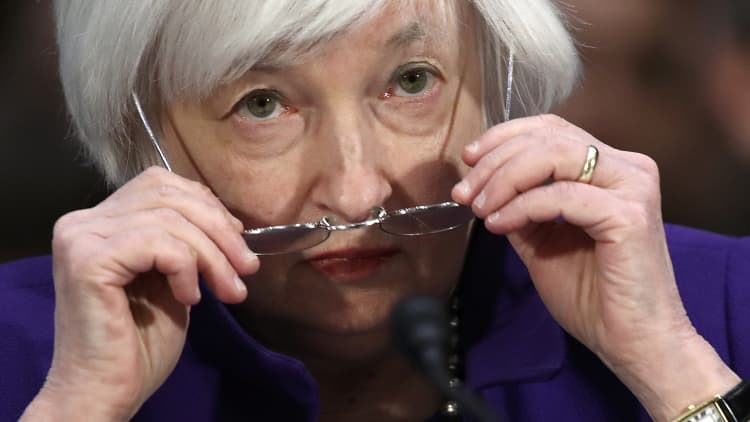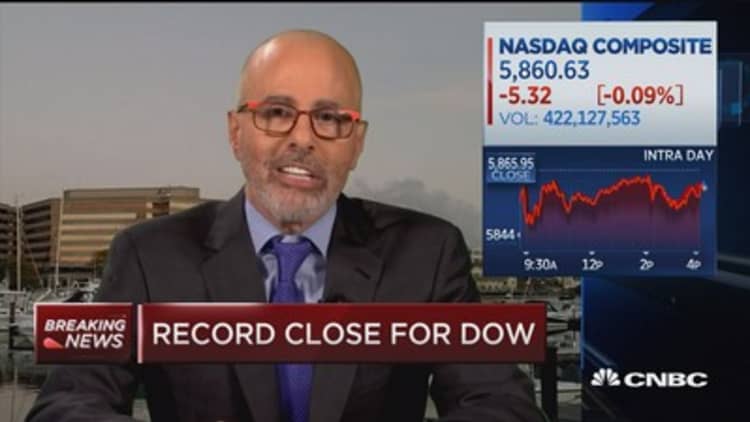
The next interest rate increase could be closer than it appears.
That's after documents released Wednesday show that Federal Reserve officials spent their meeting three weeks ago consumed with the changes brought on by a new administration in the White House — concluding with a strong indication that another hike could be just around the corner.
The Federal Open Market Committee — the central bank's policymaking arm — discussed at length the impact from lower taxes and regulations and higher domestic spending under President Donald Trump, according to minutes of the Jan. 31-Feb. 1 session.
The meeting was the first since Trump took office, following his stunning November election upset. The president's name was never mentioned in the minutes, but the broad brushes of his agenda show up often.
Members reported hearing higher levels of confidence in the business community. And they predicted that the expected increase in economic growth related to Trump's policy proposals could push the Fed into action.
"Many participants expressed the view that it might be appropriate to raise the federal funds rate again fairly soon" if data on jobs and inflation are "in line with or stronger than their current expectations," or if the risk increased that the Fed might overshoot its goals, the meeting summary stated.
Jobs numbers indeed have been solid and the consumer price index inflation indicator is at its highest level in years.
The U.S. Treasury yield curve flattened slightly following the minutes' release, with the short-term two-year note yield trading higher, near 1.23 percent, and the benchmark 10-year note yield slipping to 2.41 percent.
'An upcoming meeting'
The minutes added that "a few" members believe raising rates at "an upcoming meeting" would allow the Fed greater flexibility to respond to higher-than-expected economic growth ahead.
"There's more discussion of upside risks than we've had in a long time. This is a Fed that's turning the ship. They're gradually getting more confident that they're going to meet their goals," said Brett Ryan, senior U.S. economist at Deutsche Bank. However, he added that the minutes provided no "smoking gun" of a hike at the next FOMC meeting in March.
Market expectations currently are low for a rate hike at that meeting – about a 22 percent chance – even though the Fed in December indicated three moves could be on the way this year.
Markets currently forecast the Fed to hike in June then again in November or December, according to the CME's fed funds futures tracker.
However, central bank officials appeared to gird for a more aggressive pace.
The minutes show the committee noted "substantial uncertainty" about what changes would come, though the expectation was for a more growth-oriented agenda.
"Participants emphasized that the Committee might need to change its communications regarding the anticipated path for the policy rate if economic conditions evolved differently than the Committee expected or if the economic outlook changed," the summary said. "They pointed to a number of risks that, if realized, might call for a different policy trajectory than they currently thought most likely to be appropriate."
Most participants continued to see heightened uncertainty regarding the size, composition, and timing of possible changes to fiscal and other government policies.Federal Open Market Committee
Others cautioned that the policies and whether they will be implemented are still unknowns, and the meeting concluded without action on rates, which is what the market expected.
One example of the policy dilemma was "upside risks" that would come with "more expansionary fiscal policy or a more rapid buildup of inflationary pressures," as well as the downside risks of an appreciating U.S. dollar.
Ultimately, the Fed decided not to act on rates until they had a clearer view on the effects the new policies would have.
"Most participants continued to see heightened uncertainty regarding the size, composition, and timing of possible changes to fiscal and other government policies, and about their net effects on the economy and inflation over the medium term, and they thought some time would likely be required for the outlook to become clearer," the minutes said.
However, not everyone was on board.
There were "a couple" members who thought the Fed needed to act anyway, because there were other factors at play besides policy that could spur growth higher than the committee's expectations. One member said hiking rates now would give the Fed more flexibility ahead. Eventually, the decision not to hike passed unanimously.
Fed officials in December left their long-run GDP projection unchanged at 1.8 percent, though many Wall Street economists have been adjusting their growth estimates higher.
"Several" committee members said the probability of the Fed overshooting its dual targets for employment and inflation was "high," which could cause the committee to have to move more quickly than the market expects.
The meeting appeared to show little discussion about the Fed's $4.5 trillion balance sheet, except a note that interest rates were expected to climb once the central bank starts to run off its holdings.
— CNBC's Fred Imbert contributed to this report.



